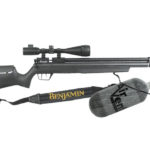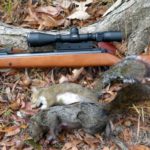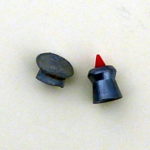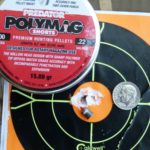
Targeting squirrels with an air rifle is a stealthy, challenging way to fill your game bag. Here’s what you need to know if you decide to leave your trusty rimfire rifle at home.
I had spent a good 30 minutes creeping up on three particularly vigilant cat squirrels. It was late in the season, and even though I was covered head to toe in a leafy Ghillie suit, it was slow going against the hyper-alert critters.
Finally closing to within 30 yards, I propped my .22 against a sapling and took aim at a squirrel sitting on a limb next to the tree trunk. The crosshairs settled on his shoulder, I squeezed the trigger, and was rewarded with the unmistakable “whop” of a solid hit.
To my surprise the squirrel jumped straight up like a startled cat, bounded to the ground and scurried to a nearby tree. After about 10 feet, however, it stopped and plopped over dead.
It was my first successful stalk with a .22 air rifle, and before the morning was over I added two more squirrels to my game bag. Needless to say, I was hooked on a new, challenging way to hunt.
Air rifle advantages
Over the last few decades, technology has steadily changed the sport of hunting. Recurved bows gave way to compounds and compounds led to wickedly accurate crossbows. The primitive weapons deer season is no longer even recognizable as such, considering one can now use centerfire rifles.
As bagging game has become easier, many sportsmen have opted to go old school to make it challenging again. There are those who hunt with nothing but long bows or traditional muzzleloaders, and now some are turning to air rifles for small game.
One obvious advantage an air rifle has over a rimfire is that it is much quieter — not entirely silent as some would believe — but quieter. A standard .22 rimfire shot is about 135 decibels and has an audible “crack” as the bullet breaks the sound barrier.
On average, an air rifle’s report is about 90 decibels and is more of a mechanical “boink,” like a crossbow. My experience has also shown that the air rifle report doesn’t seem to alarm squirrels even in late season.
Ammunition is also much cheaper for an air rifle (especially during times like our not-so-distant ammo shortage). Air rifle pellets generally cost about half as much as .22 rimfire ammunition.
Hunting techniques are the same for an air rifle and .22 rimfire, but there is more involved in putting together a good hunting air rifle and learning how to use it. There are many decisions to make: brand name, type of power mechanism, caliber, high or low velocity, open sights or scope, type of ammunition and so on.
Research your options
One is well advised to do a little research before plopping down their hard earned money. Airgun Depot (http://www.airgundepot.com/) is a good place to start your search because it carries many different brands. It’s where I purchased my German-made Diana RWS 34, and I couldn’t be happier with their service.
When looking for an air rifle, Cory Bach of the Airgun Depot Service Team, advises not to become focused on a particular brand name.
“Honestly, the particular air gun itself is more important than the manufacturer,” Bach said.
The most common air rifle calibers are .17 and .22, but size really does matter when squirrel hunting. Bach recommends a .22 caliber because the larger pellet requires less velocity to be lethal.
As for power systems, Bach believes a novice should stick with a simple break barrel pneumatic rifle, which compresses air behind a valve when you break the barrel down to insert a pellet. “[It’s] quite a good starting point for a hunting air gun,” he said.
CO2-powered air rifles are also available, but according to Bach, “CO2 is finicky when it gets cold and does not produce enough power in general. PCP is best, but it requires some support for the air gun.”
PCP stands for “pre-charged pneumatic.” Air from a scuba tank or other outside source is pumped into a reservoir that is usually located in the rifle’s buttstock. Since excess air is stored you can get up to 20 shots before having to recharge. The obvious drawback to a PCP rifle is that you need access to a scuba tank or some type of air pump.
Accuracy trumps velocity
One common mistake beginners make is buying the highest velocity air rifle possible. But Bach says, “Velocity is not as important as being able to make an accurate shot.”
For squirrel hunting, the minimum velocity needed for a clean kill is about 600 feet per second. According to Bach, anything much faster than that will pass through the squirrel without expending its energy in the body.
Accuracy is by far the most important attribute of a hunting air rifle. As Bach puts it, “Accuracy is king. No doubt on this.”
It is highly recommended that a scope be mounted on your air rifle, but be sure to get the correct one. Break barrel air rifles produce a lot of vibration, so Bach advises purchasing a scope that is air gun-rated because the vibrations can quickly damage a standard scope.
Some people advise using Loc Tite to secure the scope to the mount but Bach doesn’t believe that is necessary. “Use the supplied hex key and torque the top rings with the short part of the tool until it is good and tight,” he said.
“For the bottom where they meet the receiver, use the long part. This will give you approximately the correct torque on the screws.
“If it is a break barrel rifle and there is a scope stop pin in the ring and a hole for it in the receiver, then you will want to use it.”
Experienced shooters know that to achieve optimum accuracy, you have to experiment with different brands of ammunition and bullet weights to find the one that shoots best in a particular rifle. This is particularly true for air rifles.
Bach recommends staying away from lead-free lightweight pellets that claim to produce “maximum velocity” because they will drift in the wind and lose energy too quickly.
“The best performers are always lead pellets,” he said. “Two of my current favorites are the H&N Baracuda Hunter Extreme and the Predator Polymag. They both are outstanding performers.”
It’s recommended that you buy a packet of assorted pellets and try various brands and weights until you find the one that shoots best in your rifle.
Practice until you can hit a squirrel’s vitals (preferably the head) four out of five shots. Then, you’re ready to hunt.







